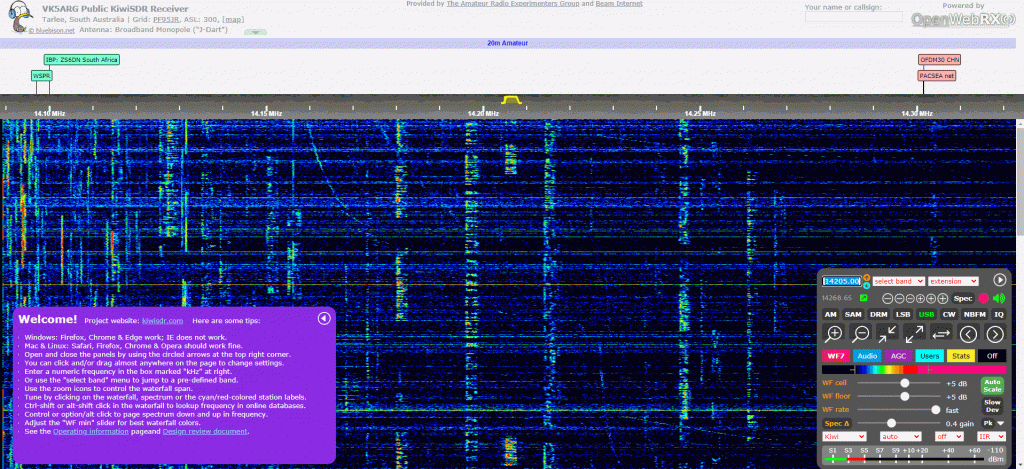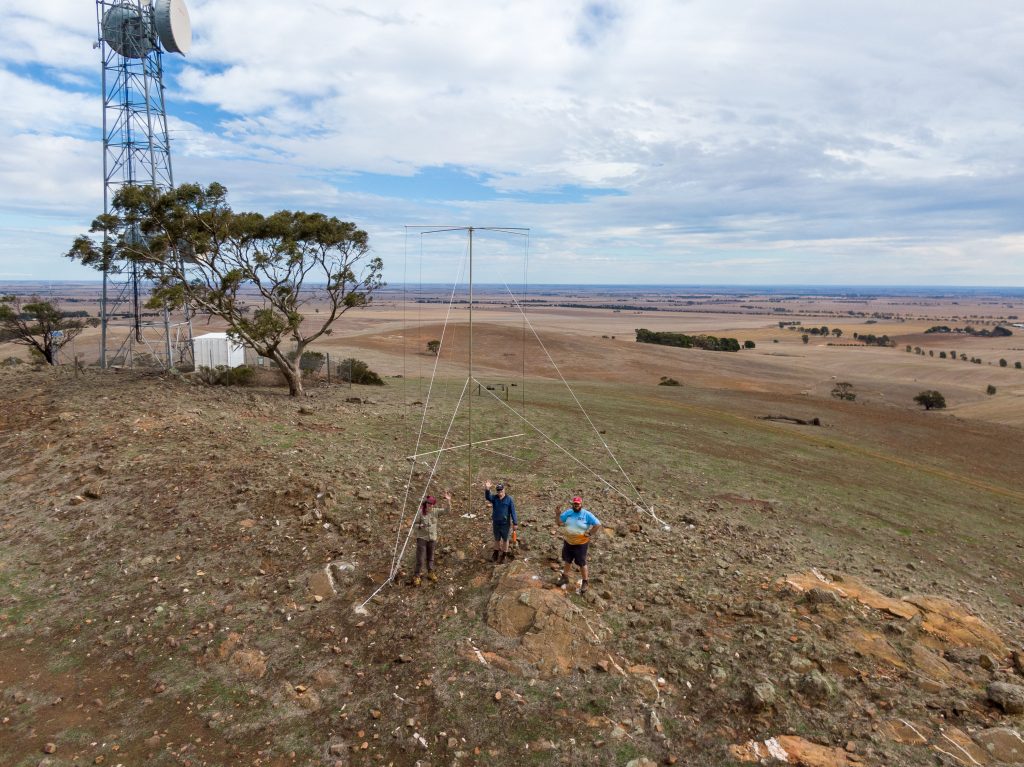 The AREG HF receive site, located ~100km north of Adelaide, in South Australia, is now operating three publicly accessible KiwiSDR 4 channel receivers. You can access the service from the following web addresses:
The AREG HF receive site, located ~100km north of Adelaide, in South Australia, is now operating three publicly accessible KiwiSDR 4 channel receivers. You can access the service from the following web addresses:
- Primary KiwiSDR Address (use this first!): http://kiwisdr.areg.org.au:8073/
- Second KiwiSDR Direct Link: http://kiwisdr.areg.org.au:8074
- Third KiwiSDR Direct Link: http://kiwisdr.areg.org.au:8075
Sometimes our KiwiSDRs go offline for a few hours for software updates. If you find a KiwiSDR is unresponsive, please try other links above. If this still doesn’t work, then email us at vk5qi@rfhead.net to report a fault.
Note – If you get a “This site could not provide a secure connection” error, then your web browser is probably trying to force your connection to HTTPS, which the KiwiSDR software does not support. You may need to modify the URL in your browser address bar to ensure it starts with http:// (not https).
 AREG wouldn’t have been able to make this possible without the support of Sam from Swoop Internet who provide wireless internet access across the Barossa Valley and northern Adelaide Plains. Thanks team for your support of experimental Amateur Radio!
AREG wouldn’t have been able to make this possible without the support of Sam from Swoop Internet who provide wireless internet access across the Barossa Valley and northern Adelaide Plains. Thanks team for your support of experimental Amateur Radio!
Using the KiwiSDR
For first time KiwiSDR users the following notes should be considered
- Windows: Firefox, Chrome & Edge work; IE does not work.
- Mac & Linux: Safari, Firefox, Chrome & Opera should work fine.
- Open and close the panels by using the circled arrows at the top right corner.
- You can click and/or drag almost anywhere on the page to change settings.
- Enter a numeric frequency in the box marked “kHz” at right.
- Or use the “select band” menu to jump to a pre-defined band.
- Use the zoom icons to control the waterfall span.
- Tune by clicking on the waterfall, spectrum or the cyan/red-colored station labels.
- Ctrl-shift or alt-shift click in the waterfall to lookup frequency in online databases.
- Control or option/alt click to page spectrum down and up in frequency.
- Adjust the “WF min” slider for best waterfall colors.
- See the Operating information page and Design review document for further information

SpectroGraph
A spectrograph provides a quick-look indication of HF band activity over a given time period. We produce a spectrograph covering three days of HF activity from one of our KiwiSDRs. This is updated every 30 minutes. HF fadeouts are often visible as sudden reductions in signal power right across the HF band, and can be correlated to increases in X-Ray flux due to solar flares.

A week-long spectrograph, shown with site weather data is available here.
WSPR Skimmer
AREG runs a WSPR skimmer at the site, using a RX888 wide-band receiver and the WSPRDaemon software. This monitors WSPR transmissions all bands from 160m through to 10m, including the 13.56 MHz ISM band. Thanks to Rob AI6VN and Phil KA9Q for assisting with the setup of this system!
The last hour of WSPR spots received can be viewed by clicking this link.
FT8 Multi-Band Skimmer
Using a 125-14 Red Pitaya multiband SDR and software from Pavel Demin (see here) AREG is now able to give you a near real time view of what FT8 signals are audible here in central southern Australia.
The Red Pitaya is sponsored by Grant VK5GR. Thank you for contributing this very interesting experiment to the site. It certainly provides an interesting insight into what bands are open when!
SSTV & EasyPal Skimmer
AREG runs a SSTV Skimmer at the site, listening for all SSTV modes on 14230 USB, and 7171 LSB. The skimmer also listens for DRM/EasyPAL signals on 7058 LSB, 7214 LSB, and 14233 USB.
The live received images are available here: https://donotsta.re/users/aregsstv
Thanks to Michaela VK3FUR for the SSTV skimmer software!
HF APRS iGates
AREG runs HF APRS iGates on the 30m, 40m, and 20m bands. These relay HF APRS traffic into APRS under the callsigns VK5ARG-3 (30m), VK5ARG-2 (20m) and VK5ARG-4 (40m).
The 30m iGate handles the most traffic, and you can find out what stations the iGate has been seeing on aprs.fi here: https://aprs.fi/info/a/VK5ARG-3
Performance Statistics
AREG continuously monitors the performance of the remote SDR site, comparing the median noise level to the upper 95th percentile level to produce a metric of Signal-to-Noise ratio, or SNR. The SNR can be observed to vary throughout the day as the HF propagation environment varies.


HF Receive Antenna Details
The receive antenna shared by all the HF receivers is a broadband monopole design, approximately 8m high and 4m wide, and has a <2.0:1 VSWR from 7 MHz to 40 MHz. 32 x 15m long ground radials are used to lower the elevation pattern of the antenna. The antenna location on top of a large hill also helps to lower the elevation pattern even further.
A rough diagram of the antenna construction is here:
The feed from the antenna enters the site equipment hut via a lightning arrestor system consisting of a ~300V spark gap, followed by a 90V gas-discharge arrestor, then a transient limiter device. The signal is then fed into a distribution amplifier consisting of a Motorola CA2818C amp (~18 dB gain, 5dB NF, 45 dBm IP3) and a 24-port splitter, providing ample ports for further expansion. A 1.8 MHz high-pass splitter has been installed prior to the amplifier to avoid overload and inter-mod issues from AM broadcast stations.
Weather Station
There is also a weather station on the site, with weather information available here, or on APRS under the callsign VK5ARG-5.
Supporters
Over and above the equipment the club has purchased for this project, there are several members who have made a direct donation/loan of equipment or who have contributed directly to the development of the site. Special thanks goes to:
- Mark Jessop VK5QI – KiwiSDR
- Matthew Cook VK5ZM – KiwiSDR
- Peter Murphy VK5KX – Lots of assistance with fabrication of bulkheads and parts for the site, and installations!
- Andrew Hall VK5AKH – KiwiSDR
- Grant Willis VK5GR – Red Pitaya (FT8 Skimmer)
- Darin Roberts VK5IX – Airspy R2 SDR (6m RX)
- Chris Platt VK5CP – Weather Station
- Gerard Rankin VK5ZQV – WSPRDaemon PC.
- David VK5KK – Backup battery system





